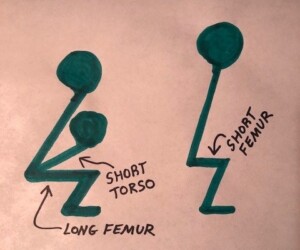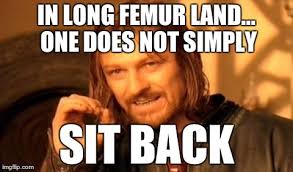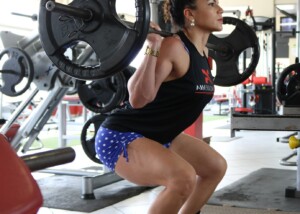
It isn’t just femur to torso ratio that can create problems with the back squat; shin length relative to upper leg can also mess things up.
You’re aware that if the femurs are longer than the torso, this will make the back squat difficult, sometimes very difficult, for an individual.
Let’s not dismiss the impact that shin length (tibia bone) can have on the squat, especially the back version.
Though I used to be a personal trainer and was keenly aware of body segment proportions of my clients, one need not be an exercise instructor to see some obvious points.
How does shin or tibia length influence the ability to sink to parallel in the back squat without excessive torso lean?
Certainly you know that to keep balance, one must keep the barbell over the ankle: a vertical point-to-point alignment.
The longer one’s femurs are without the length of the torso changing, the farther their butt is from their knees, and the more bent their torso is (a smaller angle formed by femurs and torso).
To make it easy to understand how tibia or shin length can play a role, look at the illustration below.

It’s hard to imagine the stick figure on the right falling backwards with all that tibia supporting him like a pedestal. Now, shrink the tibia to a centimeter. What happens?
Look at the figure on the left. That short (relatively) tibia has a lot of body to support.
The longer one’s shin bone, the easier it is to get the foot vertically aligned with the shoulder without having to pitch the torso way forward.
This isn’t only about ankle flexibility.
An extra inch of tibia in a person, for whom nothing else changes, will place their ankles back by about an inch, and allow that person to subtract an inch off their forward lean.
An extra inch of tibia sets the foot back about one inch, assuming that all other proportions remain the same.
The following is an excerpt from the book, “Scrawny to Brawny; The Complete Guide to Building Muscle the Natural Way,” by Michael Mejia and John Berardi, PhD.:
A femur that’s longer than your torso can compromise your ability to squat and deadlift efficiently because it will cause you to lean forward excessively to reach the desired depth.
Of course, a femur and torso of near equal length combined with a shorter lower leg can sometimes pose similar problems, although this can often be effectively managed by improving flexibility around the ankle joint.
The “lower leg” of course refers to the tibia or shin. Improving ankle flexibility allows a person to shift the knees more forward, thereby shifting the barbell more overhead of the ankle.
If you’ve been struggling with the back squat, it may not be so much that you have “long femurs,” but rather, short shins.
Everything else looks in proportion, and then you get to your short tibias. Moving the kneecaps up a few inches would make your body look more proportionate.
Long femurs do get a bad rap, but sometimes the tibia should get some of the blame.
Often, though, a person’s tibia is the same length as their femur, but their torso is shorter than their femur, making them struggle with the back squat.
 Lorra Garrick is a former personal trainer certified through the American Council on Exercise. At Bally Total Fitness she trained women and men of all ages for fat loss, muscle building, fitness and improved health.
Lorra Garrick is a former personal trainer certified through the American Council on Exercise. At Bally Total Fitness she trained women and men of all ages for fat loss, muscle building, fitness and improved health.
.


























